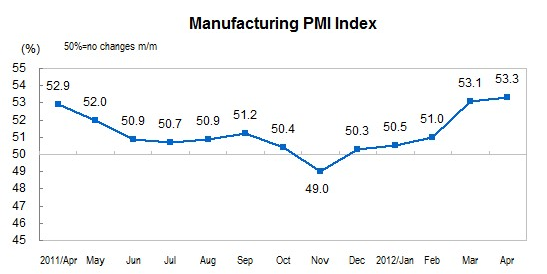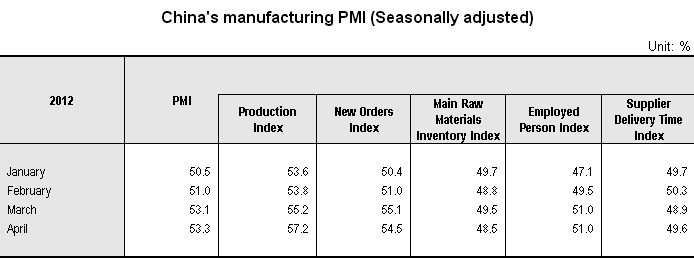In April, China's manufacturing purchasing managers index (PMI) was 53.3 percent, up by 0.2 percentage point month-on-month, continuing to stay above the threshold, while 2.7 percentage points lower than the mean value of the same period in the history.
In view of the sizes of enterprises, the PMI of medium and large -sized enterprises was 53.7 percent, a month-on-month increase of 0.3 percentage point, it was the main factors of the significant growth of manufacturing PMI. The PMI of small-sized enterprises was 49.1 percent, a month-on-month decrease of 1.8 percentage points, which below 50 percent this month after staying above the threshold for 3 consecutive months.

In April, among the five sub-indices composing PMI, two sub-indices increased, two sub-indices decreased, while that of the other one sub-index remained at the same level.
Driving by the sharply increase of the new orders index in March, the production index in April rose to 57.2 percent, 2.0 percentage points higher over than the previous month, reaching the highest point since January, 2011, and was the main driving force of the increasing of PMI this month. In view of different industries, the production of fabricated metal products manufacturing, non-metallic mineral products manufacturing, electrical machinery and equipment manufacturing, textile wearing apparel manufacturing, paper and printing industry, cultural, educational, sporting goods manufacturing increased rapidly. The production indices of automobile manufacturing, processing and coking of petroleum, smelting and processing of non-ferrous metal ores were below the threshold.
In April, the new orders index was 54.5 percent, fell by 0.6 percentage points month-on-month, and staying above the threshold for 4 consecutive months, which showed that new orders for manufacturing enterprises to maintain a steady growth momentum, but growth slowed down slightly. In view of different industries, the new orders indices of fabricated metal products manufacturing, paper and printing industry, cultural, educational, sporting goods manufacturing, tobacco manufacturing, processing of timber and furniture manufacturing, non-metallic mineral products manufacturing, electrical machinery and equipment manufacturing were all over 60 percent, the market demand gained moderate rebound. The market demands of processing and coking of petroleum, the automobile manufacturing, textiles manufacturing, chemical fiber manufacturing, rubber and plastic manufacturing decreased. In addition, the survey results showed that the export orders index was 52.2 percent, 0.3 percentage points higher over than the previous month, staying above the threshold for 3 consecutive months, which indicated that the month-on-month exports of manufacturing products continued rebounding. The import orders index was 50.5 percent, 1.0 percentage point lower month-on-month, staying above the threshold for 3 consecutive months.
Main raw materials inventory index was 48.5 percent, down by 1.0 percentage points over the previous month, below the threshold for 12 consecutive months, which indicated that the main raw material inventory of manufacturing continued to reduce. In view of different industries, the main raw materials inventory indices of paper and printing industry, cultural, educational, sporting goods manufacturing, agro-food processing industry, processing and coking of petroleum, textile wearing apparel manufacturing, electrical machinery and equipment manufacturing went up, that of railways, ship, aerospace and other transportation equipment manufacturing, automobile manufacturing, chemical fiber manufacturing, rubber and plastic manufacturing, and fabricated metal products manufacturing were below the threshold.
Employed person index was 51.0 percent, remained at the same level month-on-month, and staying above the threshold for 2 consecutive months, which indicated a growth of the manufacturing employment. In view of different industries, employed person of fabricated metallic products manufacturing, paper and printing industry, cultural, educational, sporting goods manufacturing, agro-food processing industry, computer communications, electronic equipment and instrumentation manufacturing, and textile wearing apparel manufacturing went up obviously, that of processing of timber, furniture manufacturing, special equipment manufacturing, foods, liquor, beverages and fine tea manufacturing, and textiles manufacturing went down.
Supplier delivery time index was 49.6 percent, 0.7 percentage points higher over the previous month, staying below the threshold for 2 consecutive months.
In addition, the main raw material purchase price index was 54.8 percent, dropped 1.1 percentage points over the previous month, which indicated that the increasing rate of main raw material purchase price in manufacturing sectors has narrowed. In view of different industries, the month-on-month prices of the main raw materials of the processing of petroleum and coking, agro-food processing, fabricated metal products manufacturing, foods, liquor, beverages and fine tea manufacturing, and pharmaceutical manufacturing went up. That of smelting and processing of non-ferrous metal ores, non-metallic mineral products manufacturing, textiles manufacturing, chemical fiber manufacturing, rubber and plastic manufacturing were below the threshold, procurement costs of enterprises decreased.

Annotations:
1. Explanatory Notes
Purchasing Managers Index (PMI): refers the index through the monthly summarized and compiled statistics of enterprises purchasing managers, which covers enterprises purchasing, production, logistics, and other links, is one of the leading index which common adopted by international to monitoring the macroeconomic trends, played an important role on strong forecasting and monitoring. The threshold of PMI is usually using 50 percent as the cut-off point of economy strength, PMI above 50 percent reflects the manufacturing economic is expanding; less than 50 percent reflects narrowing.
2. Statistical Coverage
Involving 28 manufacturing industry categories in the “national industry classification" (GB/T4754-2011), the number of sample enterprises of each industry was determined according to its proportion to size.
3. Survey Methods
Manufacturing purchasing managers’ survey was conducted in 820 sampling enterprises, selected by stage, stratified and PPS sampling method from the manufacturing enterprises in the whole country, and carry through the monthly interview to enterprises’ purchasing managers.
4. Calculation Methods
Manufacturing purchasing managers survey involving 11 questions on production, new orders, export orders, existing orders, finished goods inventory, purchase, import, purchase prices, raw materials, inventory, employees, suppliers, delivery time, and etc.. Diffusion index was calculated on each question, i.e. percentage of positive answers in number of enterprises plus half of the percentage in the same answers.
PMI is a composite index, which used weighted method to calculate five diffusion indices (group index numbers). The 5 group index numbers and its weight are based on its leading impact on the economy. Including: new orders index, weighted 30 percent; production index, weight is 25 percent; employees index, weighted 20 percent; supplier delivery time index, weighted 15 percent; raw materials inventory index, weighted 10 percent.





